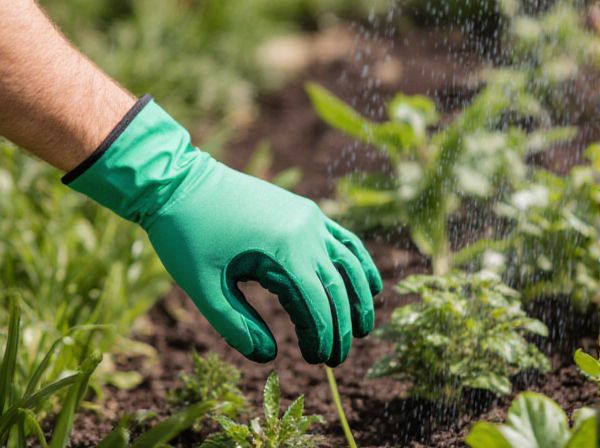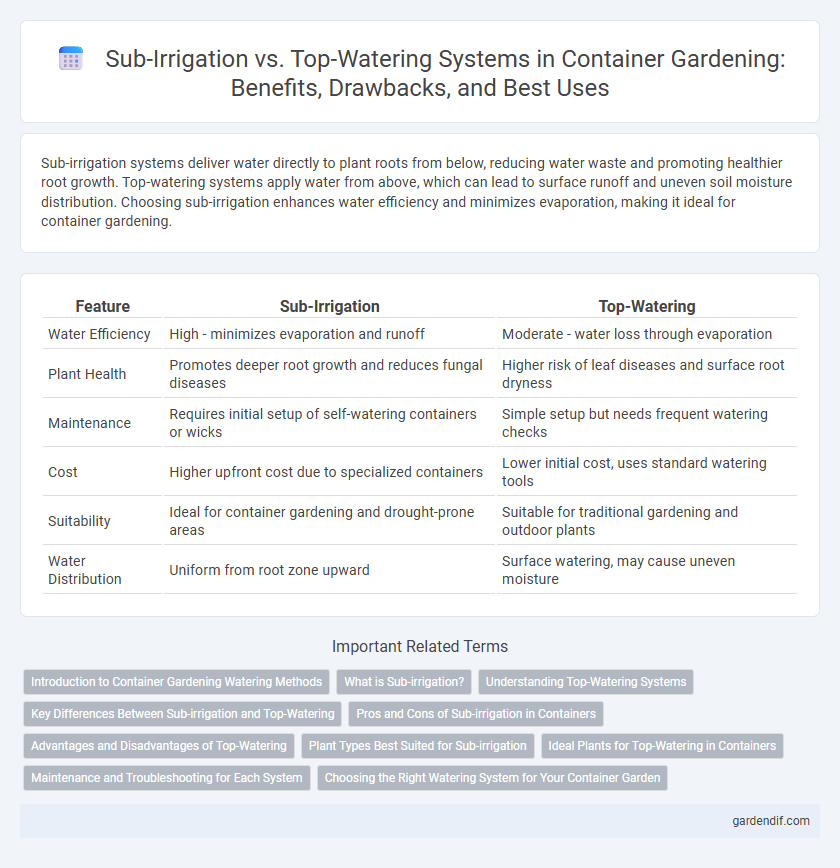
Sub-irrigation vs top-watering systems Illustration
Sub-irrigation systems deliver water directly to plant roots from below, reducing water waste and promoting healthier root growth. Top-watering systems apply water from above, which can lead to surface runoff and uneven soil moisture distribution. Choosing sub-irrigation enhances water efficiency and minimizes evaporation, making it ideal for container gardening.
Table of Comparison
| Feature | Sub-Irrigation | Top-Watering |
|---|---|---|
| Water Efficiency | High - minimizes evaporation and runoff | Moderate - water loss through evaporation |
| Plant Health | Promotes deeper root growth and reduces fungal diseases | Higher risk of leaf diseases and surface root dryness |
| Maintenance | Requires initial setup of self-watering containers or wicks | Simple setup but needs frequent watering checks |
| Cost | Higher upfront cost due to specialized containers | Lower initial cost, uses standard watering tools |
| Suitability | Ideal for container gardening and drought-prone areas | Suitable for traditional gardening and outdoor plants |
| Water Distribution | Uniform from root zone upward | Surface watering, may cause uneven moisture |
Introduction to Container Gardening Watering Methods
Sub-irrigation systems deliver water directly to the plant roots through a reservoir, enhancing efficiency by reducing evaporation and runoff in container gardening. Top-watering systems involve applying water from above, promoting natural soil aeration but increasing the risk of overwatering and fungal diseases. Choosing between sub-irrigation and top-watering depends on factors such as plant type, container design, and user convenience.
What is Sub-irrigation?
Sub-irrigation is a watering method where plants absorb water from the bottom through a reservoir, allowing roots to take up moisture directly. This system promotes efficient water use by minimizing evaporation and runoff, resulting in healthier root development and reduced water waste. Sub-irrigation containers often feature a built-in water reservoir and wicking mechanism to maintain consistent soil moisture levels.
Understanding Top-Watering Systems
Top-watering systems deliver water directly to the soil surface, promoting rapid absorption and easy control over moisture levels in container plants. This method reduces the risk of fungal diseases by keeping foliage dry while ensuring even distribution of water across the root zone. Efficient drainage must be maintained to prevent waterlogging and root rot in containers using top-watering techniques.
Key Differences Between Sub-irrigation and Top-Watering
Sub-irrigation systems deliver water directly to the plant roots through a reservoir or wicking mechanism, promoting efficient water use and minimizing surface evaporation. In contrast, top-watering systems supply water from above, which can lead to uneven moisture distribution, increased evaporation, and potential fungal problems on foliage. Sub-irrigation enhances oxygen availability to roots and reduces water runoff, whereas top-watering requires more frequent irrigation and careful monitoring to avoid overwatering.
Pros and Cons of Sub-irrigation in Containers
Sub-irrigation systems in containers offer efficient water use by delivering moisture directly to the root zone, reducing evaporation and minimizing water waste. These systems promote healthier plant growth by maintaining consistent soil moisture levels, but they can lead to overwatering and root rot if drainage is insufficient. Maintenance can be more complex compared to top-watering, requiring regular monitoring of water reservoirs and ensuring no buildup of salts or algae.
Advantages and Disadvantages of Top-Watering
Top-watering systems offer precise water delivery directly to the soil surface, promoting rapid absorption and reducing water waste through evaporation. However, frequent top-watering can lead to soil erosion, water runoff, and increased risk of foliar diseases due to prolonged leaf wetness. Despite ease of application and flexibility, top-watering may require more water compared to sub-irrigation and demands careful monitoring to avoid over-saturation and nutrient leaching.
Plant Types Best Suited for Sub-irrigation
Sub-irrigation systems are ideal for water-loving plants such as herbs, lettuce, and African violets that require consistent moisture levels. These systems promote deep root growth and reduce water stress, making them suitable for container-grown vegetables and tropical plants. Succulents and cactus generally do not thrive in sub-irrigation due to their preference for drier conditions.
Ideal Plants for Top-Watering in Containers
Ideal plants for top-watering in containers include moisture-tolerant species such as herbs like basil and parsley, as well as flowering plants like petunias and impatiens. These plants benefit from top-watering because their root systems thrive with surface moisture and do not require constant hydration from below. Top-watering is suitable for containers with well-draining soil, preventing waterlogging and promoting healthy root aeration for these plant types.
Maintenance and Troubleshooting for Each System
Sub-irrigation systems require regular monitoring of water reservoirs and wicking mechanisms to prevent algae growth and blockages, with troubleshooting often involving unclogging emitters or adjusting water levels to ensure consistent moisture. Top-watering systems demand frequent inspection of sprinkler heads or drip emitters to avoid clogging, uneven water distribution, and potential fungal growth on foliage; maintenance includes cleaning filters and ensuring uniform spray patterns. Both systems benefit from routine checks to maintain optimal plant hydration while minimizing water waste and system malfunctions.
Choosing the Right Watering System for Your Container Garden
Sub-irrigation systems deliver water directly to the plant roots through a reservoir, reducing evaporation and promoting efficient moisture absorption in container gardens. Top-watering methods apply water from above, which can increase the risk of soil erosion and fungal diseases but allow for more immediate hydration. Selecting the optimal system depends on container size, plant species, and maintenance preferences, with sub-irrigation favored for water conservation and consistent moisture control.
Sub-irrigation vs top-watering systems Infographic

 gardendif.com
gardendif.com